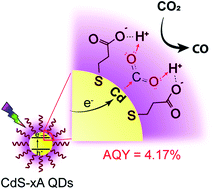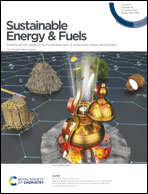Highly efficient proton-assisted photocatalytic CO2 reduction over 3-mercaptopropionic acid-capped quantums dots†
Abstract
Herein, we demonstrate that 3-mercaptopropionate capping agents on CdS quantum dot surfaces could serve as proton shutters and localize protons near the active sites towards efficient photocatalytic CO2 reduction. A series of water-soluble 3-mercaptopropionic acid (MPA)-capped CdS quantum dots with different molar ratios of MPA : Cd (denoted as CdS-xA) are successfully synthesized via an aqueous synthesis, promoting the formation of surface Cd atoms as active sites in photocatalytic CO2 reduction. The enhanced photocatalytic activity of functional CdS quantum dots could be attributed to the cooperative interaction between localized protons and surface Cd atoms, which behave as a Lewis acid and Lewis base, respectively. The representative CdS-1A exhibits the highest CO generation rate of ∼16 μmol h−1 with apparent quantum yield of 4.17% at 420 nm under optimized conditions, which is one of the highest values reported for CdS-based materials. This work aims to understand the important role of protons localized near active sites, which can promote efficient photocatalytic CO2 to CO reduction.



 Please wait while we load your content...
Please wait while we load your content...